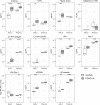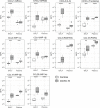Pulmonary Procoagulant and Innate Immune Responses in Critically Ill COVID-19 Patients
- PMID: 34054832
- PMCID: PMC8160522
- DOI: 10.3389/fimmu.2021.664209
Pulmonary Procoagulant and Innate Immune Responses in Critically Ill COVID-19 Patients
Abstract
Rationale: Systemic activation of procoagulant and inflammatory mechanisms has been implicated in the pathogenesis of COVID-19. Knowledge of activation of these host response pathways in the lung compartment of COVID-19 patients is limited.
Objectives: To evaluate local and systemic activation of coagulation and interconnected inflammatory responses in critically ill COVID-19 patients with persistent acute respiratory distress syndrome.
Methods: Paired bronchoalveolar lavage fluid and plasma samples were obtained from 17 patients with COVID-19 related persistent acute respiratory distress syndrome (mechanical ventilation > 7 days) 1 and 2 weeks after start mechanical ventilation and compared with 8 healthy controls. Thirty-four host response biomarkers stratified into five functional domains (coagulation, complement system, cytokines, chemokines and growth factors) were measured.
Measurements and main results: In all patients, all functional domains were activated, especially in the bronchoalveolar compartment, with significantly increased levels of D-dimers, thrombin-antithrombin complexes, soluble tissue factor, C1-inhibitor antigen and activity levels, tissue type plasminogen activator, plasminogen activator inhibitor type I, soluble CD40 ligand and soluble P-selectin (coagulation), next to activation of C3bc and C4bc (complement) and multiple interrelated cytokines, chemokines and growth factors. In 10 patients in whom follow-up samples were obtained between 3 and 4 weeks after start mechanical ventilation many bronchoalveolar and plasma host response biomarkers had declined.
Conclusions: Critically ill, ventilated patients with COVID-19 show strong responses relating to coagulation, the complement system, cytokines, chemokines and growth factors in the bronchoalveolar compartment. These results suggest a local pulmonary rather than a systemic procoagulant and inflammatory "storm" in severe COVID-19.
Keywords: COVID-19; bronchoalveolar space; coagulation; innate immune response; persistent ARDS.
Copyright © 2021 Nossent, Schuurman, Reijnders, Saris, Jongerius, Blok, de Vries, Duitman, Vonk Noordegraaf, Meijboom, Lutter, Heunks, Bogaard and van der Poll.
Conflict of interest statement
The authors declare that the research was conducted in the absence of any commercial or financial relationships that could be construed as a potential conflict of interest.
Figures





Similar articles
-
Quantitative SARS-CoV-2 RT-PCR and Bronchoalveolar Cytokine Concentrations Redefine the COVID-19 Phenotypes in Critically Ill Patients.J Intensive Care Med. 2024 Jun;39(6):525-533. doi: 10.1177/08850666231217707. Epub 2024 Apr 17. J Intensive Care Med. 2024. PMID: 38629466
-
Caspase-1 activation, IL-1/IL-6 signature and IFNγ-induced chemokines in lungs of COVID-19 patients.Front Immunol. 2025 Jan 15;15:1493306. doi: 10.3389/fimmu.2024.1493306. eCollection 2024. Front Immunol. 2025. PMID: 39882243 Free PMC article.
-
High Levels of Neutrophil Extracellular Traps Persist in the Lower Respiratory Tract of Critically Ill Patients With Coronavirus Disease 2019.J Infect Dis. 2021 May 20;223(9):1512-1521. doi: 10.1093/infdis/jiab050. J Infect Dis. 2021. PMID: 33507309 Free PMC article.
-
Pathophysiology of coronavirus disease 2019 for wound care professionals.Int Wound J. 2020 Dec;17(6):1935-1940. doi: 10.1111/iwj.13483. Epub 2020 Sep 28. Int Wound J. 2020. PMID: 32986928 Free PMC article. Review.
-
Bronchoalveolar hemostasis in lung injury and acute respiratory distress syndrome.J Thromb Haemost. 2013 Jan;11(1):17-25. doi: 10.1111/jth.12047. J Thromb Haemost. 2013. PMID: 23114008 Review.
Cited by
-
From Cytokine Storm to Cytokine Breeze: Did Lessons Learned from Immunopathogenesis Improve Immunomodulatory Treatment of Moderate-to-Severe COVID-19?Biomedicines. 2022 Oct 18;10(10):2620. doi: 10.3390/biomedicines10102620. Biomedicines. 2022. PMID: 36289881 Free PMC article. Review.
-
Patterns of C1-Inhibitor Plasma Levels and Kinin-Kallikrein System Activation in Relation to COVID-19 Severity.Life (Basel). 2024 Nov 21;14(12):1525. doi: 10.3390/life14121525. Life (Basel). 2024. PMID: 39768234 Free PMC article.
-
Patients with SARS-CoV-2-Induced Viral Sepsis Simultaneously Show Immune Activation, Impaired Immune Function and a Procoagulatory Disease State.Vaccines (Basel). 2023 Feb 13;11(2):435. doi: 10.3390/vaccines11020435. Vaccines (Basel). 2023. PMID: 36851312 Free PMC article.
-
A Literature Review of Pathophysiology, Clinical Manifestations, Medications and Optimal Dosage, Outpatient, and Post-hospitalization Use of Anticoagulation in COVID-19 Patients.Anatol J Cardiol. 2023 May;27(5):232-239. doi: 10.14744/AnatolJCardiol.2023.3023. Anatol J Cardiol. 2023. PMID: 37119193 Free PMC article. Review.
-
Inflammatory and Immune Responses during SARS-CoV-2 Infection in Vaccinated and Non-Vaccinated Pregnant Women and Their Newborns.Pathogens. 2023 Apr 29;12(5):664. doi: 10.3390/pathogens12050664. Pathogens. 2023. PMID: 37242334 Free PMC article.
References
Publication types
MeSH terms
Substances
LinkOut - more resources
Full Text Sources
Other Literature Sources
Medical
Research Materials

